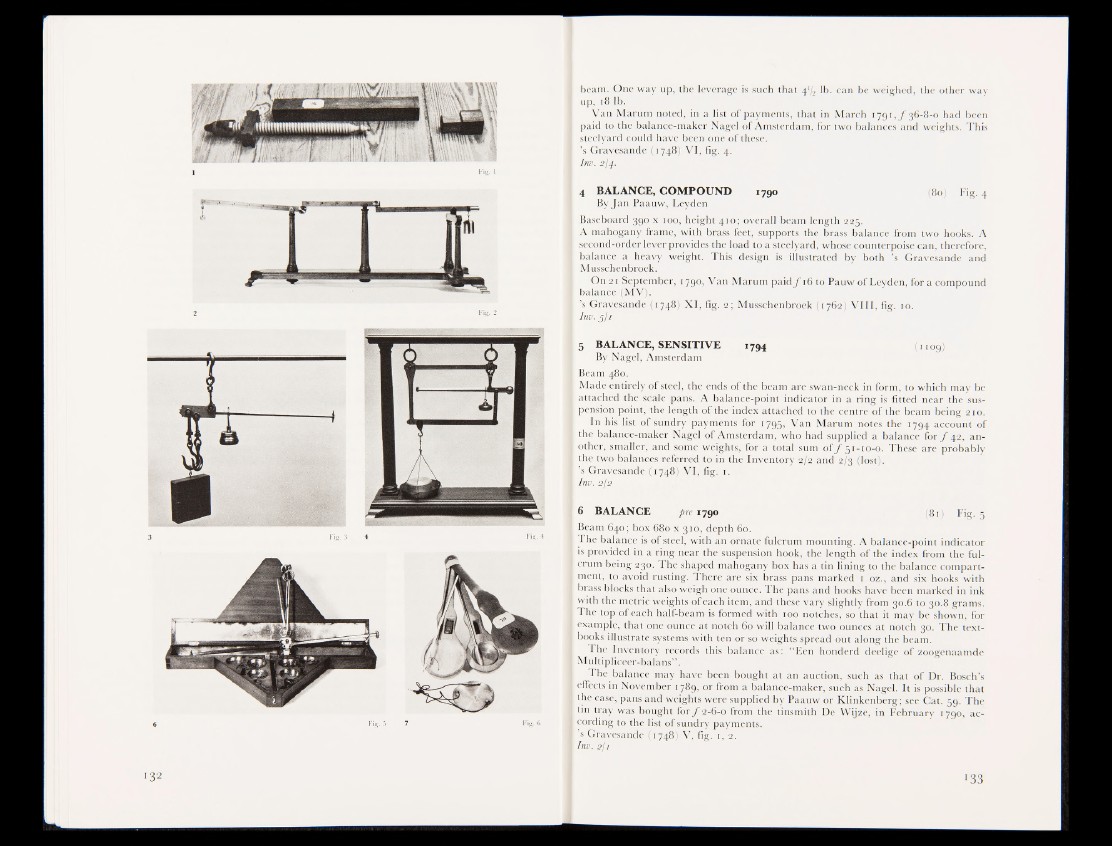
beam. One way up, the leverage is such that 472 lb. can be weighed, the other way
up, 18 lb.
Van Marum noted, in a list of payments, that in March 1791, ƒ 36-8-0 had been
paid to the balance-maker Nagel of Amsterdam, for two balances and weights. This
steelyard could have been one of these.
’s Gravesande I I 748) VI, fig. 4.
Inv. 214.
4 BALANCE, COMPOUND 1790 (80) Fig. 4
By Jan Paauw, Leyden
Baseboard 390 x too, height 410; overall beam length 225.
A mahogany frame, with brass feet, supports the brass balance from two hooks. A
second-order lever provides the load to a steelyard, whose counterpoise can, therefore,
balance a heavy weight. Thilgdesign is illustrated by both ’s Gravesande and
Musschenbroek.
On 21 September, 179°: Van Marum paid ƒ 16 to Pauw of Leyden, for a compound
balance (MV).
’s Gravesande (1748) XI, fig. 2; Musschenbroek (1762) VIII, fig. 10.
Ink H
5 BALANCE, SENSITIVE 1794 (1109)
By Nagel, Amsterdam
Beam 480.
Made entirely of steel, the ends of the beam are swan-neck in form, to which may be
attached the scale pans. A balance-point indicator in a ring is fitted near the suspension
point, the length of the index attached to the centre of the beam being 210.
In his list of sundry payments for 1795, Van Marum notes the 1794 account of
the balance-maker Nagel of Amsterdam, who had supplied a balance for ƒ 42, another,
smaller, and Some weight#,;Tor a total sum of ƒ 51-10-0. These are probably
the two balances referred to in the Inventory 2/2 and 2/3 (lost).
’s Gravesande |;li 748) VI, fig. 1.
Irtv Wjt’2
6 BALANCE pre 1790 (81) Fig. 5
Beam 640; box 680 x 310, depth 60.
The balance is of steel, with an ornate fulcrum mounting. A balance-point indicator
is provided in a ring near the suspension hook, the length of the index from the fulcrum
being 230. The shaped mahogany box has a tin lining to the balance compartment,
to avoid rusting. There are six brass pans marked 1 oz., and six hooks with
brass blocks that also weigh one ounce. The pans and hooks have been marked in ink
with the metric weights of each item, and these vary slightly from 30.6 to 30.8 grams.
The top of each half-beam is formed with 100 notches, so that it may be shown, for
example, that one ounce at notch 60 will balance two ounces at notch 30. The textbooks
illustrate systems with ten or so weights spread out along the beam.
The Inventory records this balance as: “ Een honderd deelige of zoogenaamde
Multipliceer-balans” .
The balance may have been bought at an auction, such as that of Dr. Bosch’s
November 1789, or from a balance-maker, such as Nagel. It is possible that
the case, pans and weights were supplied by Paauw or Klinkenberg; see Gat. 59. The
tin tray was bought fo r / 2-6-0 from the tinsmith De Wijze, in February 1790, according
to the list of sundry payments.
’s Gravesande (1748) V, fig. 1, 2.
Inv. sfi